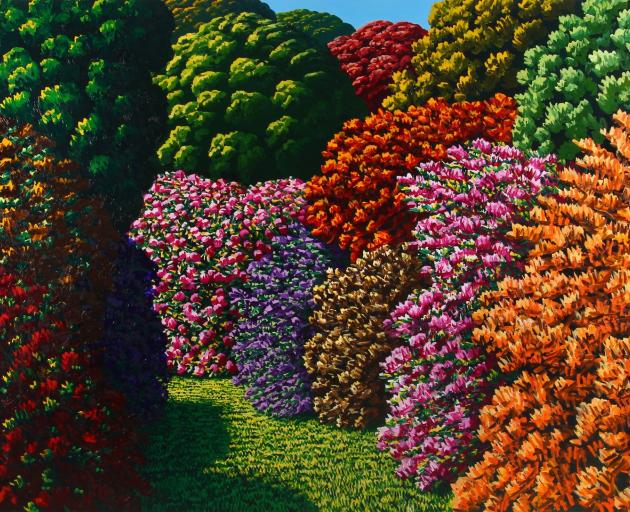In this week's Art Seen, Robyn Maree Pickens looks at exhibitions from Otago Arts Socierty, Karl Maughan and Brett McDowell.
 An Old Flat-Footed Cabbage Tree, by Madeleine Child
''Landfall Exhibition'' (Otago Arts Society)
An Old Flat-Footed Cabbage Tree, by Madeleine Child
''Landfall Exhibition'' (Otago Arts Society)

As Rebecca Fox has recently noted, a large group exhibition that celebrates the cross-pollination of art and literature opened last week at the Otago Art Society. Artists were asked to respond to any issue of Landfall, the longest running literary and arts journal in New Zealand. The responses span a range of media including painting, print, sculpture, ceramics and textiles.
Dunedin-based artist Madeleine Child chose to respond to a poem by Sam Hunt titled Postcard of a Cabbage Tree, published in Landfall 92 in December 1969.
Child drew her inspiration from a twice-repeated line, ''an old flat-footed cabbage tree'', choosing to fuse adjectival description (''old flat-footed'') with subject (''cabbage tree'') to invent a new hybrid being: a flat-footed cabbage tree.
In Child's ceramic work a slender ochre and brown leg with one very large, flat foot emerges from a cabbage trees characteristic frond skirt topped by foliage resembling a Dr Seuss haircut.
In a complex chain of responses, Sharon Singer created a cubist-inspired painting in response to a prose account of cubist artist Braque by artist and writer John Tarlton.
That is, Singer responded in a cubist style to the cubist artist Braque as mediated by John Tarlton (published in Landfall 117, March 1976). Singer's sky is fragmented in the style of Braque's cubism, but is full of Aramoana light.
 Ohakea, by Karl Maughan
''Tangimoana'', Karl Maughan (Milford Galleries)
Ohakea, by Karl Maughan
''Tangimoana'', Karl Maughan (Milford Galleries)

Karl Maughan gardenscapes of brilliant flowering shrubs in a tightly-compressed composition are instantly recognisable. Each painting has a garden path, or a suggestion of one, that leads the viewer through the bright shrubs to a mid-distant range of predominantly green foliage.
Often one side of the path and shrubbery will be cast in shadow. Given the centrality of gardens in Western religious traditions, it is tempting (pun intentional) to consider the garden with path, and contrasting light and shadow as a trope, though not necessarily a religious one.
In the context of this exhibition, and the artists oeuvre more broadly, Maughan's paintings pivot on this tension between insistent life and the shadow of decay, even as the stridency of the orange, pink, purple, and yellow flower bushes appear to resist cyclical imperatives. There is urgency, if not near emergency to the high tone of these colours as they press in on the viewer. Even in shadow the brilliance of the flowers is barely dimmed.
Maughan's boxy compositions amplify a feeling of compression. All of the action takes place in the foreground as it graduates to mid-ground. By cropping out the sky and reducing depth in this way, the flowers perpetual bloom begins to feel uncanny, as if this is turbo nature. Although figurative, Maughan's iterative practice approaches abstraction.
 The Kawaguchi Ferry and Zenko-ji Temple, by Hiroshige
''Hiroshige'', Hiroshige (Brett McDowell)
The Kawaguchi Ferry and Zenko-ji Temple, by Hiroshige
''Hiroshige'', Hiroshige (Brett McDowell)

Brett McDowell has assembled and framed a stunning collection of Japanese woodblock prints by Utagawa Hiroshige (1797-1858), who is widely acknowledged as one of the preeminent masters of the Ukiyo-e tradition. Hiroshige developed a particular appreciation for the unique features of the Japanese landscape that he depicted in all its seasonal distinction.
The 11 works encompass meandering rivers traversed by ferries, delicate willows arching downwards to the waters' edge, the tapering square tops of temples, rolling hills, spectacular rocky outcrops, a creep of fog, steep grey mountains, small villages and roaming travellers navigating a treacherous path or expanse of water.
Each scene is accompanied by a citation in Japanese script that describes the scene, and includes the artists name, and date of printing. In some instances, this inscription hangs like a narrow silk banner, and at others, the calligraphic script is painted directly on the print itself.
Despite the activity in each landscape there is a sparseness to these prints that bears an aesthetic resemblance to the Japanese poetry form of haiku. The large flat areas of colour, often with minimal texture or adornment are akin to the accomplished brevity of haiku.
These prints have been selected not only for their beauty, but for their rich vibrant colour some 190 years after they were made.












